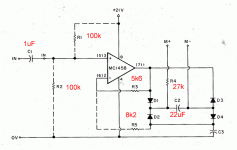Here is an idea:
1. Use the LM3916 as a log display.
2. Make two active rectifiers: VU and peak.
3. Make a CMOS oscillator at ca 50-150Hz.
4. Use a CMOS audio switch-selector (4016,66,4051,52,53) and synchronously switch (using the oscillator) dot/bar mode and source signal (peak/VU) on the LM3916 .
This method should allow you to get VU reading in the bar mode and peak reading in the dot mode.
Regards,
Milan
1. Use the LM3916 as a log display.
2. Make two active rectifiers: VU and peak.
3. Make a CMOS oscillator at ca 50-150Hz.
4. Use a CMOS audio switch-selector (4016,66,4051,52,53) and synchronously switch (using the oscillator) dot/bar mode and source signal (peak/VU) on the LM3916 .
This method should allow you to get VU reading in the bar mode and peak reading in the dot mode.
Regards,
Milan
moamps said:Here is an idea:
1. Use the LM3916 as a log display.
2. Make two active rectifiers: VU and peak.
3. Make a CMOS oscillator at ca 50-150Hz.
4. Use a CMOS audio switch-selector (4016,66,4051,52,53) and synchronously switch (using the oscillator) dot/bar mode and source signal (peak/VU) on the LM3916 .
This method should allow you to get VU reading in the bar mode and peak reading in the dot mode.
I also had the idea of using both a bar mode display and a separate dot-mode one to display the peaks. Your method would work but I think that it is needlessly complicated. Since the LM3915/6 has open-collector outputs, you can simply connect two chips to the same LEDs. That way either or both can draw current throught each LED, superimposing the bar display (for instantaneous level) with the dot display (for peak level).
Attachments
I got it to work using his method.
used a bilateral switch, an op-amp oscillator, and two op amp active rectifiers with different RC time constants.
It works, but the only thing I dont like about it, it wont hold the peaks for a nano second, and it will slowly fall.
If i use a bigger cap, it will hold the peaks, but take way to long to fall.
I want it to hold the peaks for 1 second, and fall very rapidly. Not hold the peaks for a nano second, and fall like turtles.
hmmm.
used a bilateral switch, an op-amp oscillator, and two op amp active rectifiers with different RC time constants.
It works, but the only thing I dont like about it, it wont hold the peaks for a nano second, and it will slowly fall.
If i use a bigger cap, it will hold the peaks, but take way to long to fall.
I want it to hold the peaks for 1 second, and fall very rapidly. Not hold the peaks for a nano second, and fall like turtles.
hmmm.
How about holding the peaks for a second or so and then resetting (rather than falling)? This would be easy to do; just use a big cap in the peak detector and wire up a transistor to discharge the cap. You would need to generate a short pulse once per second to drive the transistor.
Another way to create interesting displays like this is to use a microcontroller. It would read the value from the rectifier/peak-detector and then generate the display for the LEDs. The behaviour of the display is limited only by your imagination and coding skills. This is a project that I plan to do someday, but it will have to wait for some others on my list.
Another way to create interesting displays like this is to use a microcontroller. It would read the value from the rectifier/peak-detector and then generate the display for the LEDs. The behaviour of the display is limited only by your imagination and coding skills. This is a project that I plan to do someday, but it will have to wait for some others on my list.
Yes. Use a NPN transistor, emitter to ground, collector to cap + terminal, and use a ~1 to 2 k or so resisitor from the base to the drive signal (to limit base current).if I understand this right, I would hook the transistor's C and E across the cap? and then pulse the base to saturate the transistor to short the cap out?
using a 1% duty, normally low, pulse high?
I'm use LB1412 from Sanyo for this project.
http://www.profusionplc.com/static/images/data sheets/lb1412.pdf
http://www.profusionplc.com/static/images/data sheets/lb1412.pdf
from the datasheet, that was probably the IC they used in the deck.
it would hold high-order peaks, and that was it.
The high order peaks were red squares, and any lower than that was just lines. and were below 0db, anything above 0 was high order.
Thats about right.
So, accorsing to the internal quivalent schematic, its just a bunch of nor gates and D-type flip flops. I figured it had to be something.
it would hold high-order peaks, and that was it.
The high order peaks were red squares, and any lower than that was just lines. and were below 0db, anything above 0 was high order.
Thats about right.
So, accorsing to the internal quivalent schematic, its just a bunch of nor gates and D-type flip flops. I figured it had to be something.
Check the BA6800 datasheet.
http://pdf.alldatasheet.co.kr/datasheet-pdf/view/36121/ROHM/BA6800.html
Regards,
Milan
http://pdf.alldatasheet.co.kr/datasheet-pdf/view/36121/ROHM/BA6800.html
Regards,
Milan
here's a peak reading VU meter schematic for the Revox A77 -- an acurate peak reading meter is not a rigorously defined VU meter --a VU is one milliwat dissipated into a 600 ohm load. the ballistics of a VU meter are such that it reaches 99% of the peak value in 300 milliseconds, whereas a peak meter will read this in some milliseconds. a lot of things have changed since 1939 when the VU was defined.
Attachments
- Status
- This old topic is closed. If you want to reopen this topic, contact a moderator using the "Report Post" button.
- Home
- Design & Build
- Parts
- Peak-hold VU meter

